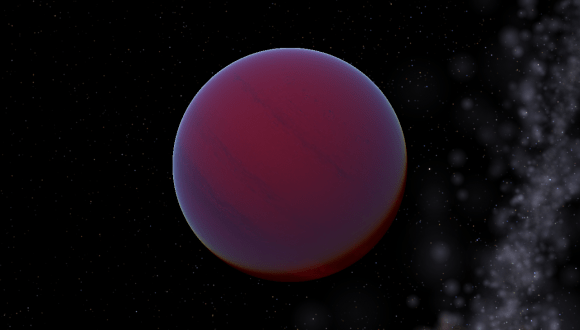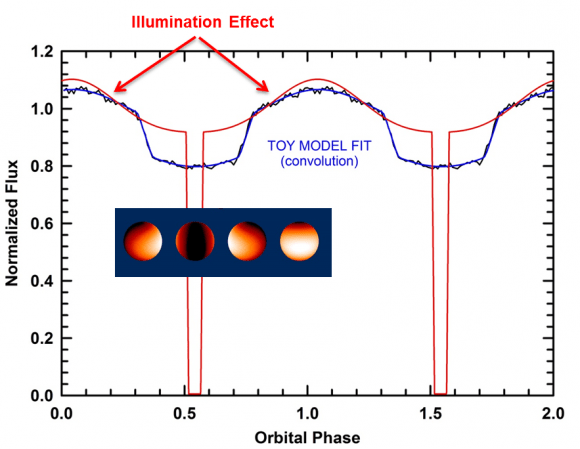Death is simply a part of life, and this is no less the case where stars and other astronomical objects are concerned. Sure, the timelines are much, much greater where these are concerned, but the basic rule is the same. Much like all living organism, stars eventually reach old age and become white dwarfs. And some are not even fortunate enough to be born, instead becoming a class of failed stars known as brown dwarfs.
Despite being familiar with these objects, astronomers were certainly not expecting to find examples of both in a single star system! And yet, according to a new study, that is precisely what an international team of astronomers discovered when looked at WD 1202-024. Using data from the Kepler space telescope, they spotted a binary system consisting of a failed star (a brown dwarf) and the remnant of a star (a white dwarf).
The team which made the discovery consisted of researchers from the Kavli Institute for Astrophysics and Space Research at MIT, the Harvard-Smithsonian Center for Astrophysics (CfA), the Exoplanet Research Institute (iREx) and NASA’s Ames Research Center. The study that describes their findings, titled “WD 1202-024: The Shortest-Period Pre-Cataclysmic Variable“, was recently published in the Monthly Notices of the Royal Astronomical Society.
Artist’s impression of a T-type brown dwarf. Credit: Tyrogthekreeper under a Wikimedia Commons Attribution-Share Alike 3.0 Unported license
Whereas the transits of exoplanets are known to cause small dips in brightness, the light curve in this case showed particularly deep and broad eclipses. In addition, between these eclipses, there were changes in brightness which appeared to be due to the cool component (i.e. the brown dwarf) being illuminated by the much hotter white dwarf. This too was unexpected, as it indicated that the transiting object was rather large.
To get to the bottom of this, the team devised a model based on data obtained from K2 mission, the SDSS survey and the Magellan 6.5-m telescope. They also used data from five different ground-based telescopes on three continents, which included amateur-operated 36-cm and 80-cm telescopes in Arizona, the 1-m telescope at the South African Astronomical Observatory, and the 1.6-m telescope at Mont-Megantic Observatory (‘OMM’) in Quebec.
From this combined data, they were able to deduce that their observations were consistent with a hot white dwarf of 0.4 Solar masses being eclipsed by brown dwarf companion of 0.067 Solar masses. They also determined that these two objects, which are seen nearly edge-on, orbited each other with a period of just 71 minutes and 12 seconds – which works out to a speed of about 100 km/s.
The lightcurve picked up by the K2 mission (black line), with a geometrical model to emulate an illumination effect on the companion star (red line), while the blue line is the fit to the model based on the length of the K2 observations.. Credit: UBishop
To do this, they used sophisticated computer models to simulate the formation and evolution of WD1202. According to their scenario, the primordial system consisted of a 1.25 Solar mass star and a brown dwarf that were in a 150 day orbit with each other. As the star aged, it began to expand, becoming a red giant that eventually pulled its brown dwarf companion into a much tighter orbit.
They also constructed a 3-D animation to illustrate the effect this had. As Nelson described it:
“It is similar to an egg-beater effect. The brown dwarf spirals in towards the center of the red giant and causes most of the mass of the red giant to be lifted off of the core and to be expelled. The result is a brown dwarf in an extraordinarily tight, short-period orbit with the hot helium core of the giant. That core then cools and becomes the white dwarf that we observe today.”In addition, their calculations showed that the primordial binary must have formed about 3 billion years ago, and that in less than 250 million years, the white dwarf will begin cannibalizing the brown dwarf. At this point, the brown dwarf is likely to be pulled apart and form a circumstellar disk around the white dwarf, which it will slowly accrete material from.
Artist’s impression of the star in its multi-million year long and previously unobservable phase as a large, red supergiant. Credit: CAASTRO / Mats Björklund (Magipics)
So perhaps the find was not so sad after all. Yes, a failed star is orbiting a star in its death throes, but its important to remember they were not always this way. At one time, WD 1202-024 was a vital star that was orbited by a super-heavy gas giant. Only in approaching death did the two become so tight in their orbits, and the perfect picture of failed stardom and near-stellar-death. And in time, they will come together to produce a cataclysmic explosion. I think we can all agree, its best to go out with a bang!
The findings of this study were presented at a press conference last week (on Tuesday, June 6th, 2017) at the 230th Meeting of the American Astronomical Society.
Further Reading: Bishop’s University, MNRAS
The post This is Kind of Sad. Astronomers Find a Failed Star Orbiting a Dead Star appeared first on Universe Today.



No comments:
Post a Comment